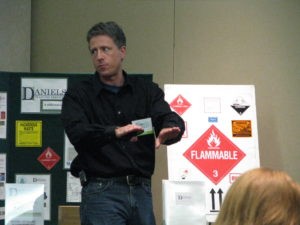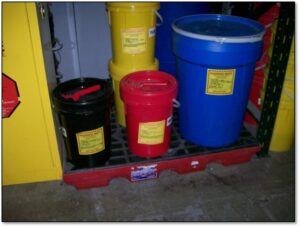Federal regulations of the U.S. Environmental Protection Agency (USEPA) require a small quantity generator of hazardous waste (SQG) to maintain equipment and processes to prevent a hazardous waste emergency and to respond to it if one occurs. The regulations are found in the following SQG conditions for exemption:
- 40 CFR 262.16(b)(8) Preparedness and prevention
- 40 CFR 262.16(b)(9) Emergency procedures
This article is the seventh in a series that closely examines and explains these regulations.
In the previous article in this series I addressed the requirements of 40 CFR 262.16(b)(8)(vi) Arrangements with Local Authorities for a Small Quantity Generator. That was the last of the Preparedness and Prevention requirements of §262.16(b)(8). This article is the first of §262.16(b)(9) identifying the SQGs emergency response requirements.
The purpose of this article: 40 CFR 262.16(b)(9)(i) Emergency coordinator for small quantity generator of hazardous waste.
Before we begin…
These regulations were revised by the Generator Improvements Rule. If your state has not yet adopted the new rule you must continue to comply with the earlier version until it does. You may read an article explaining the earlier version of the regulations (prior to implementation of the Generator Improvements Rule) here.
After your state adopts the Generator Improvements Rule, it may choose to make its version of these regulations more stringent and more broad than these Federal regulations. The actions of your state will vary based on whether or not it has an authorized hazardous waste program. Be sure to check the regulations of your state to ensure compliance.
Scope and applicability:
The regulations addressed in this article are applicable to a SQG. The responsibility of a large quantity generator of hazardous waste (LQG) are quite different and found elsewhere in the regulations (40 CFR 262, subpart M). If you are a LQG please refer to this article for your version of these regulations: The Requirements of 40 CFR 262.264 Emergency Coordinator for Large Quantity Generator of Hazardous Waste
Or, you may refer to the entire Preparedness, Prevention, and Emergency Response Procedures for a Large Quantity Generator of Hazardous Waste.
|
Not sure of your hazardous waste generator category? |
The placement of these regulations squarely within 40 CFR 262.16 Conditions for exemption for a small quantity generator that accumulates hazardous waste removes any doubt that these regulations apply solely to a SQG.
But where at a SQG? The entire facility? And what operations? Just those related to hazardous waste management? In the preamble to the final rule in the Federal Register, USEPA stated its primary objective was to ensure these regulations do not apply to the entire facility (November 28, 2016, FR 81, 85792). However, USEPA did clarify that these regulations – and all preparedness, prevention, and emergency response procedures of both SQG and LQG – are applicable to all areas of a facility where hazardous waste is:
- Generated. This means all points of generation.
Accumulated. This includes both central accumulation area(s) (CAA) and satellite accumulation area(s) (SAA).
- Those areas where allowable treatment of hazardous waste may occur in accumulation units (November 28, 2016, FR 81, 85792).
All satellite accumulation areas operated by a small quantity generator must meet the preparedness and prevention regulations of §262.16(b)(8) and emergency procedures of §262.16(b)(9). Prior to the Generator Improvements Rule agency guidance and enforcement limited the applicability of these regulations solely to hazardous waste in the CAA and did not include the SAA. To clarify its position in the preamble, USEPA also added the following to the revised regulations for SAAs at §262.15(a)(7):
All satellite accumulation areas operated by a small quantity generator must meet the preparedness and prevention regulations of §262.16(b)(8) and emergency procedures of §262.16(b)(9).
This is further reinforced by the opening paragraph of §262.16(b)(9), which reads:
The small quantity generator complies with the following conditions for those areas of the generator facility where hazardous waste is generated and accumulated:
|
Like this article? Subscribe to my Monthly Newsletter No marketing emails! |
40 CFR 262.16(b)(9)(i) reads:
At all times there must be at least one employee either on the premises or on call (i.e., available to respond to an emergency by reaching the facility within a short period of time) with the responsibility for coordinating all emergency response measures specified in paragraph (b)(9)(iv) of this section. This employee is the emergency coordinator.
Why the change?
No change to the text of this regulation. It remains as it did before the Generator Improvements Rule. The only change – revealed in Scope and Applicability – is that now the emergency coordinator’s responsibilities include all areas of the facility where hazardous waste is generated, accumulated, or treated.
|
Interested in site specific training at your site that covers this topic, and more! Ask me about my Onsite Training |
What’s the Point?
The whole point of §262.16(b)(9)(i) is to ensure that at least one employee of the facility is available on-site to coordinate all emergency response measures taken by or for the SQG.
“At all times…”
The same language as that used for the LQG; and just as clear. “At all times…” means 24/7/365, not just the facility’s hours of operation or when hazardous waste is present.
|
Contact me with any questions you may have about the generation, identification, management, and disposal of hazardous waste Daniels Training Services, Inc. 815.821.1550 |
“…at least one employee…”
There are two important points in this snippet of a sentence. I’ll deal with the easier one first:
- The emergency coordinator(s) must be an employee of the SQG. A consultant or other vendor will not suffice even if they are able to meet all of the other requirements described in §262.16(b)(9(i).
- While strict interpretation of the regulations may lead you to believe one emergency coordinator will suffice, USEPA – and more likely, your state – will disagree. Since an emergency coordinator must be available at all times, at least one alternate emergency coordinator in addition to the primary will be required to provide around-the-clock and vacation coverage (p. 19 of RO 13221). Even two may not be enough. As the generator, you must decide how many emergency coordinators are necessary.
Two Options for Availability of the Emergency Coordinator(s):
Just two. That’s it. The regulations require the emergency coordinator to be available at all times. In practice – and as required by the regulations – the emergency coordinator for a SQG must be one of the following:
- Physically on the generator premises.
- On call. This means the emergency coordinator is not on the premises but able to reach the facility within a short period of time.
But what is a short period of time? That term is deliberately vague and left undefined by USEPA (your state may specify a period of time). Given the importance of the emergency coordinator to the SQG’s response, I believe they are meant to be at the facility very soon after – if not before – the arrival of the local emergency responders.
When selecting your facility’s emergency coordinator(s), the proximity of their home to the SQG should be a factor. Someone living too far away (and not able to reach the facility in a short period of time) may only be qualified to be an emergency coordinator when they are on site.
Responsibility of the SQG Emergency Coordinator:
Here is where the regulations for a SQG diverge significantly from the LQG. The regulations for the LQG’s emergency coordinator at §262.264 contain a long list of emergency procedures to be implemented by the emergency coordinator and specific knowledge and abilities he/she must have. It’s nothing quite like that for the emergency coordinator of a SQG. The sole responsibility of the SQG emergency coordinator is to coordinate all emergency response measures specified in §262.16(b)(9)(iv). This includes:
- Respond to fire.
- Contain and clean-up a spill.
- Notify National Response Center if a reportable incident.
|
Contact me the next time hazardous waste generator training is due to expire. |
A quick Summary:
- The emergency coordinator must be an employee of the SQG.
- You’re going to need at least two and probably many more than that.
- One must be on site or on call at all times.
- Emergency coordinators must be capable of coordinating the emergency response activities of §262.16(b)(9)(iv).
Is that it?
No. First of all, as a SQG you must still comply with the remaining requirements of §262.16(b)(9) for emergency procedures and there remains the preparedness and prevention regulations of §262.16(b)(8). You may view all of those regulations here.

And then, what about training? At §262.16(b)(9)(iii) – a future article – it mandates the SQG ensure that all employees are thoroughly familiar with proper waste handling and emergency procedures…While not calling for documented training, clearly some form of instruction or information must be presented to hazardous waste personnel of a SQG.

 Accumulated. This includes both
Accumulated. This includes both 